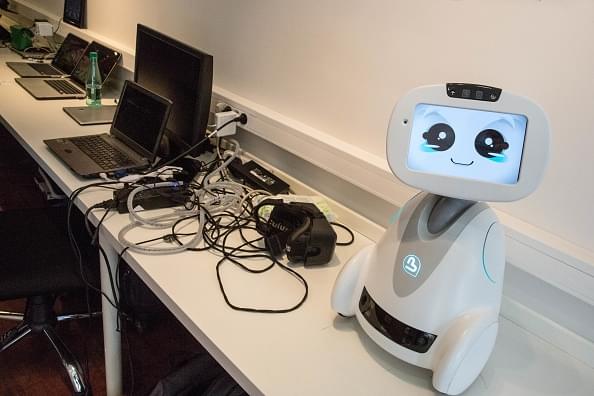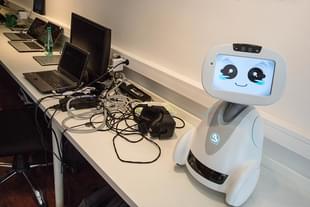Magazine
To Survive Cognitive Revolution, Our IT Engineers Need To Move Out Of Their Comfort Zone
Prithwis Mukerjee
Aug 03, 2017, 06:49 PM | Updated 06:00 PM IST
Save & read from anywhere!
Bookmark stories for easy access on any device or the Swarajya app.


Rapid advances in machine learning and the spectacular success of artificial intelligence (AI) software in, say, self-driving cars, voice recognition and chatbots for customer service are sending shivers of anxiety through professionals of the Information Technolgy (IT) sector. The havoc that robots and automation technology have wrought with the jobs of blue-collar workers on the shopfloor is now travelling upward into white-collar offices and not a day passes without a new report about automation eliminating jobs.
In India, the IT sector—that includes actual software developers, application maintenance staff, tech support personnel and BPO call centre operators—seems to be particularly vulnerable and it is no secret that a sense of doom and gloom hangs over the cubicles and around coffee machines in large and small IT companies.
To make matters worse, some companies have started to shed mid-level people managers, who have stopped writing code for years, and even senior managers who give poor returns of billability on their bloated salaries. The last straw on the back of the vanishing optimism is the reduction in campus hiring of busloads of low-quality engineers from the hundreds of engineering colleges that have mushroomed on the promise of the Y2K-inspired IT revolution.
How much of this gloomy scenario is true and what can be done to bring the sunshine back? Obviously there is no quick fix, but let us explore the terrain to seek a way out of these difficult times.
Tata Consultancy Services (TCS), the biggest IT company in India, was founded in 1968 and its 3.75 lakh employees generate a revenue of $18 billion while Microsoft, founded in 1975, pulls in $86 billion with 1.2 lakh employees. These, and similar statistics have been used ad nauseum to pontificate that India must move up the value chain from TCS-style services to Microsoft-style products.
But why has this not happened despite being talked about for years? One reason of course is the distance from the customer.
Before the advent of the world wide web, a software developer in India would be so far removed from both the technology and the customer for the technology that it would have been impossible for him to create anything relevant. Hence the great divide between the smaller, H1B-fuelled onsite gang and their poor cousins in the offshore team. But even this results in only more services but no products. However, with the internet bridging the gap, this should not have been an issue—except that it still is!
It is said that the eclectic ecosystem of Silicon Valley, with its simmering cauldron of technology evangelists, dreamers, brilliant programmers, venture capitalists, along with legal and infrastructural support, is a fertile bed where innovative products sprout like weeds. Then how come Skype, that defines web-based video conferencing, was developed in Estonia, a country of 1.3 million people that most of us may not be able to locate on a map?
Similarly, AVG, one of the most popular anti-virus products, was developed in the Czech Republic, a country with only 16 million people. But India, with over 1,000 million people, of whom three million are software professionals, is yet to create any software product that has global acceptance and recognition.
Do Indians not know how to write programs? That is highly unlikely, given the size of the IT sector in India, but what is surely missing is the ability to complete the full cycle of identifying requirements, architecting the design, securing funding, coding, building the product and eventually managing and monetising intellectual property rights. Instead, what our professionals know and do best is to receive instructions from an overseas client and code to their specifications.
This inability to go beyond meticulously following instructions, and that too at a price point so beloved of our overseas clients, is the root cause of the insecurity created by the arrival of AI. This technology is best geared to target tasks that are reasonably well-defined and needs to be done repetitively. This means that in the spectrum of IT services, call centre operations and tech support jobs are the most vulnerable. Neither is application maintenance any safer because fault diagnostics and repair is something that AI can do pretty well.
What is most safe is new application, or product, development—though even here, there are rapid application development tools that reduce the effort, and people required—and that is where Indian IT is on its weakest wicket.
One reason why we in India are unable to come up with new products is that as a people, we are very cosy in our respective zones of comfort. Our reverence for what is old, established and running is phenomenal and we are very reluctant to try out anything new. Consider the transition from MS Office, with which all of us are comfortable, to cloud-based free products like Google Docs, Sheets and Slides.
Despite the fact that web connectivity is as ubiquitous as electricity for our IT folks, and that the Google products meet all the requirements of 95 per cent of IT professionals, they will almost inevitably begin with MS Office whenever they want to create a new document. Why? Zone of comfort! This inability to try out something new inhibits our mid-level managers from “dirtying their hands” with any new technology. In fact, for many of our managers, trying out technology is considered infra dig. Most of them prefer “management” tasks like allocation of people, attending client conference calls, preparing schedules, recording and tracking issues in minutes of the meeting and so on, because all that this needs is comfort with email and MS Office.
In fact many managers overtly claim that it is beneath their dignity to touch code—something left to the new hires—when the covert reality is that it is beyond their ability to do so.
In fact, this reluctance to actually “do something new” is part of a larger tendency of being involved with consumption and avoiding creation. We would rather read a webpage than actually write a blog. It is an even greater effort for us to write a book when print-on-demand services are available for anyone who wants to publish on his own.
The genesis of this mindset of consumption can perhaps be traced back to the path that our kids take from classrooms in schools to the desk at the IT company. Given the historical scarcity of jobs and the lure of campus placements, there is a mad rush for engineering entrance examinations because only those who can crack exams get selected for engineering and then placed in IT and even non-IT companies.
The creative types, who are misfits in the rigid constraints of coaching classes, are automatically excluded not just from our engineering colleges but subsequently from the corporate sector. But the exam-crackers, most of whom have been successfully hammered by coaching institutes to abandon their originality and conform to patterns required by entrance examinations, enter the sector, rise through the ranks and in a pernicious cycle, recruit more and more conformists like them, thus perpetuating the scarcity of creativity and innovation in our IT companies.
But all that is history. It is easy to say that we must change the system, but that is neither something that will happen very soon nor will it benefit anyone in the IT industry today. What should one do to stay employable and relevant?
First, stop blaming the system, the nation or your company and take charge of your life. Light a fire under your seat and move out of your zone of comfort. Install an RSS reader in your browser and instead of reading client mail and following company gossip, keep an eye on RSS feeds from Slashdot, TechCrunch and Wired for the latest technology trends—say, machine learning or cybersecurity. Create blogs, contribute on discussion forums. Google and locate technology tutorials.
Invest time and money—lots of time and a little money, because not everything is free—to acquire new skills. Skip that latest smartphone and instead, buy a personal laptop to install new experimental software that your employer’s security policy bars on company machines. Write code, build proofs-of-concept, purchase hosting services to make these applications public and highlight these in your LinkedIn profile.
Go beyond the laptop, get a Raspberry Pi or an Arduino, connect it to a smartphone or even a drone—available online in India—to create something that people can touch and play with. Obviously things will not work as easily as they do in office projects but Stackoverflow is always there to help one go past the bleeding edge.
Finally, get your kids out of coaching classes and encourage them to join you in exploring new technology! Move from the cool comfort of consumption to the caustic crucible of creation.
AI is certainly a threat to all those who stay within their zone of comfort. But technology offers infinite possibilities for those who choose to stay relevant through this fourth revolution—agricultural, industrial, digital and now cognitive—in human society.
Prithwis Mukerjee is an engineer by education, a teacher by profession, a programmer by passion and an imagineer by intention. He has recently published an Indic themed science fiction novel, Chronotantra.




